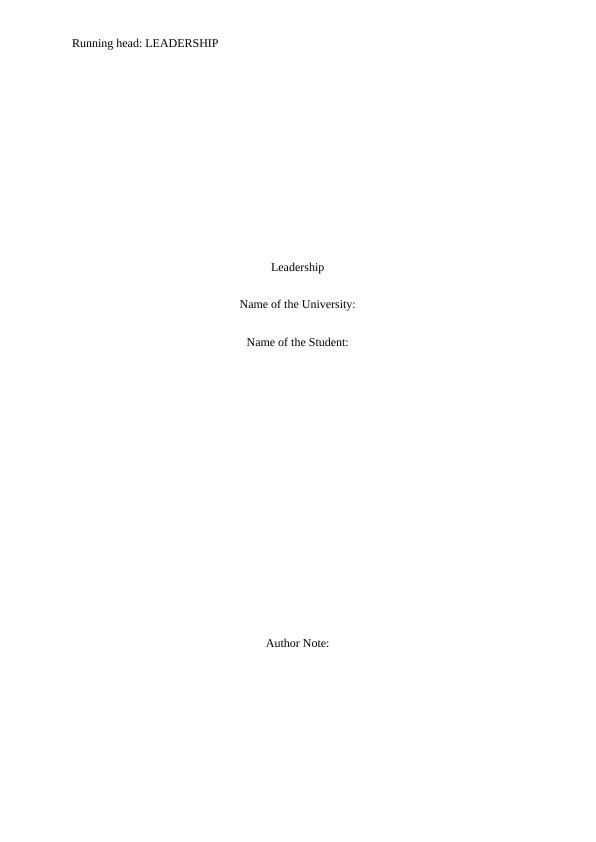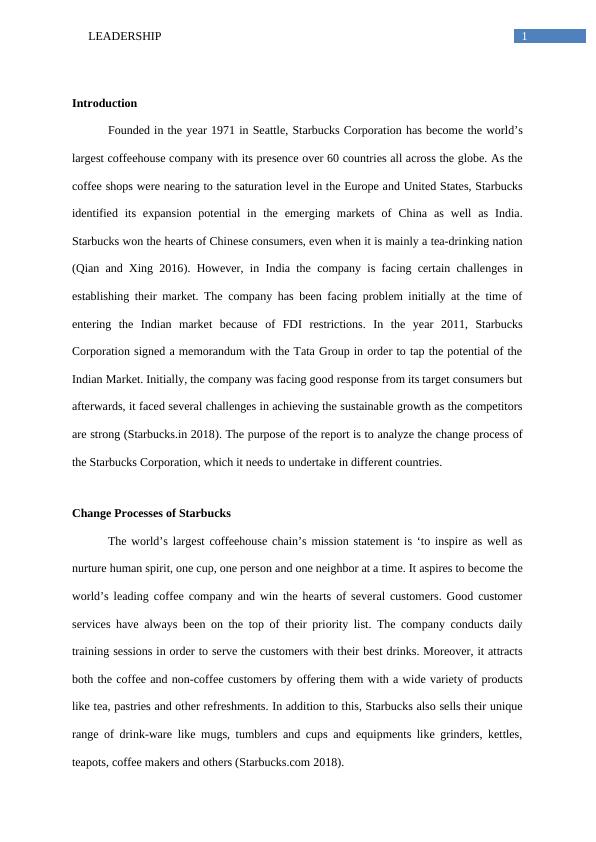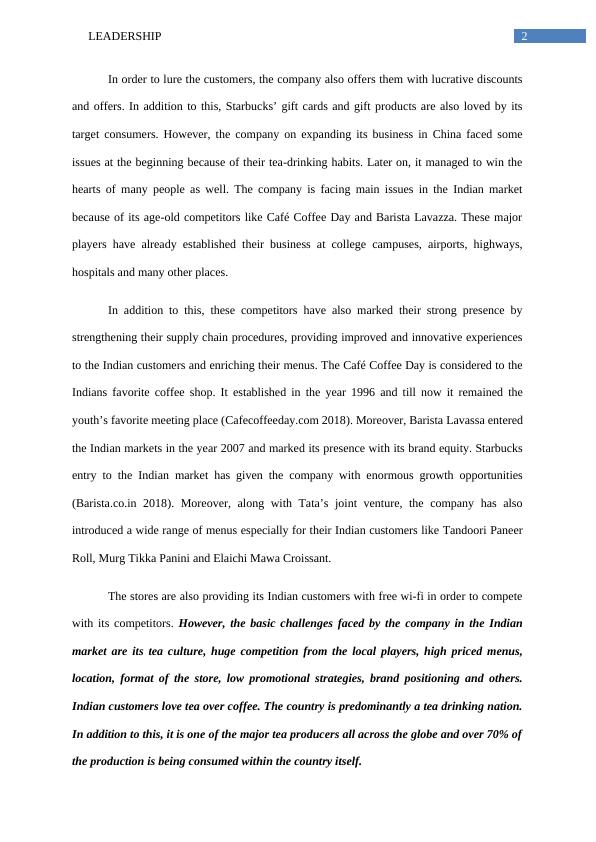Change Processes of Starbucks in Emerging Markets: A Case Study
Added on 2023-06-11
8 Pages2022 Words429 Views
Running head: LEADERSHIP
Leadership
Name of the University:
Name of the Student:
Author Note:
Leadership
Name of the University:
Name of the Student:
Author Note:

1LEADERSHIP
Introduction
Founded in the year 1971 in Seattle, Starbucks Corporation has become the world’s
largest coffeehouse company with its presence over 60 countries all across the globe. As the
coffee shops were nearing to the saturation level in the Europe and United States, Starbucks
identified its expansion potential in the emerging markets of China as well as India.
Starbucks won the hearts of Chinese consumers, even when it is mainly a tea-drinking nation
(Qian and Xing 2016). However, in India the company is facing certain challenges in
establishing their market. The company has been facing problem initially at the time of
entering the Indian market because of FDI restrictions. In the year 2011, Starbucks
Corporation signed a memorandum with the Tata Group in order to tap the potential of the
Indian Market. Initially, the company was facing good response from its target consumers but
afterwards, it faced several challenges in achieving the sustainable growth as the competitors
are strong (Starbucks.in 2018). The purpose of the report is to analyze the change process of
the Starbucks Corporation, which it needs to undertake in different countries.
Change Processes of Starbucks
The world’s largest coffeehouse chain’s mission statement is ‘to inspire as well as
nurture human spirit, one cup, one person and one neighbor at a time. It aspires to become the
world’s leading coffee company and win the hearts of several customers. Good customer
services have always been on the top of their priority list. The company conducts daily
training sessions in order to serve the customers with their best drinks. Moreover, it attracts
both the coffee and non-coffee customers by offering them with a wide variety of products
like tea, pastries and other refreshments. In addition to this, Starbucks also sells their unique
range of drink-ware like mugs, tumblers and cups and equipments like grinders, kettles,
teapots, coffee makers and others (Starbucks.com 2018).
Introduction
Founded in the year 1971 in Seattle, Starbucks Corporation has become the world’s
largest coffeehouse company with its presence over 60 countries all across the globe. As the
coffee shops were nearing to the saturation level in the Europe and United States, Starbucks
identified its expansion potential in the emerging markets of China as well as India.
Starbucks won the hearts of Chinese consumers, even when it is mainly a tea-drinking nation
(Qian and Xing 2016). However, in India the company is facing certain challenges in
establishing their market. The company has been facing problem initially at the time of
entering the Indian market because of FDI restrictions. In the year 2011, Starbucks
Corporation signed a memorandum with the Tata Group in order to tap the potential of the
Indian Market. Initially, the company was facing good response from its target consumers but
afterwards, it faced several challenges in achieving the sustainable growth as the competitors
are strong (Starbucks.in 2018). The purpose of the report is to analyze the change process of
the Starbucks Corporation, which it needs to undertake in different countries.
Change Processes of Starbucks
The world’s largest coffeehouse chain’s mission statement is ‘to inspire as well as
nurture human spirit, one cup, one person and one neighbor at a time. It aspires to become the
world’s leading coffee company and win the hearts of several customers. Good customer
services have always been on the top of their priority list. The company conducts daily
training sessions in order to serve the customers with their best drinks. Moreover, it attracts
both the coffee and non-coffee customers by offering them with a wide variety of products
like tea, pastries and other refreshments. In addition to this, Starbucks also sells their unique
range of drink-ware like mugs, tumblers and cups and equipments like grinders, kettles,
teapots, coffee makers and others (Starbucks.com 2018).

2LEADERSHIP
In order to lure the customers, the company also offers them with lucrative discounts
and offers. In addition to this, Starbucks’ gift cards and gift products are also loved by its
target consumers. However, the company on expanding its business in China faced some
issues at the beginning because of their tea-drinking habits. Later on, it managed to win the
hearts of many people as well. The company is facing main issues in the Indian market
because of its age-old competitors like Café Coffee Day and Barista Lavazza. These major
players have already established their business at college campuses, airports, highways,
hospitals and many other places.
In addition to this, these competitors have also marked their strong presence by
strengthening their supply chain procedures, providing improved and innovative experiences
to the Indian customers and enriching their menus. The Café Coffee Day is considered to the
Indians favorite coffee shop. It established in the year 1996 and till now it remained the
youth’s favorite meeting place (Cafecoffeeday.com 2018). Moreover, Barista Lavassa entered
the Indian markets in the year 2007 and marked its presence with its brand equity. Starbucks
entry to the Indian market has given the company with enormous growth opportunities
(Barista.co.in 2018). Moreover, along with Tata’s joint venture, the company has also
introduced a wide range of menus especially for their Indian customers like Tandoori Paneer
Roll, Murg Tikka Panini and Elaichi Mawa Croissant.
The stores are also providing its Indian customers with free wi-fi in order to compete
with its competitors. However, the basic challenges faced by the company in the Indian
market are its tea culture, huge competition from the local players, high priced menus,
location, format of the store, low promotional strategies, brand positioning and others.
Indian customers love tea over coffee. The country is predominantly a tea drinking nation.
In addition to this, it is one of the major tea producers all across the globe and over 70% of
the production is being consumed within the country itself.
In order to lure the customers, the company also offers them with lucrative discounts
and offers. In addition to this, Starbucks’ gift cards and gift products are also loved by its
target consumers. However, the company on expanding its business in China faced some
issues at the beginning because of their tea-drinking habits. Later on, it managed to win the
hearts of many people as well. The company is facing main issues in the Indian market
because of its age-old competitors like Café Coffee Day and Barista Lavazza. These major
players have already established their business at college campuses, airports, highways,
hospitals and many other places.
In addition to this, these competitors have also marked their strong presence by
strengthening their supply chain procedures, providing improved and innovative experiences
to the Indian customers and enriching their menus. The Café Coffee Day is considered to the
Indians favorite coffee shop. It established in the year 1996 and till now it remained the
youth’s favorite meeting place (Cafecoffeeday.com 2018). Moreover, Barista Lavassa entered
the Indian markets in the year 2007 and marked its presence with its brand equity. Starbucks
entry to the Indian market has given the company with enormous growth opportunities
(Barista.co.in 2018). Moreover, along with Tata’s joint venture, the company has also
introduced a wide range of menus especially for their Indian customers like Tandoori Paneer
Roll, Murg Tikka Panini and Elaichi Mawa Croissant.
The stores are also providing its Indian customers with free wi-fi in order to compete
with its competitors. However, the basic challenges faced by the company in the Indian
market are its tea culture, huge competition from the local players, high priced menus,
location, format of the store, low promotional strategies, brand positioning and others.
Indian customers love tea over coffee. The country is predominantly a tea drinking nation.
In addition to this, it is one of the major tea producers all across the globe and over 70% of
the production is being consumed within the country itself.

End of preview
Want to access all the pages? Upload your documents or become a member.
Related Documents
Motives for Starbucks' Joint Venture in Indialg...
|6
|1614
|85
Global Marketing Environment: A Case Study of Starbucks in Indialg...
|9
|2677
|232
CX770401 Contemporary Issues in Organisationslg...
|20
|5799
|174
Starbucks Corporation | PESTLE Analysislg...
|17
|5015
|85
Starbucks: External and Internal Analysislg...
|16
|5332
|29
Management accountinglg...
|15
|4439
|185
